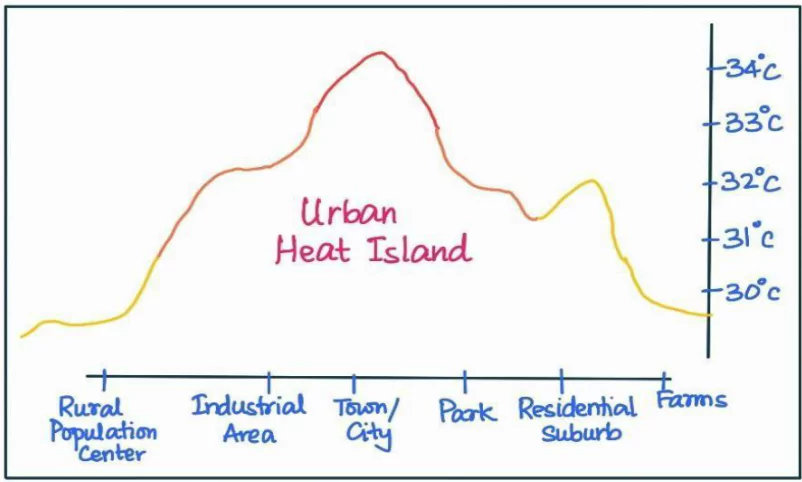Answer:
|
How to approach this question?
- Introduction
- Define the urban heat island effect.
- Body
- Briefly discuss the phenomenon.
- Discuss the causes of the effect.
- Discuss the impacts on local climate, air quality, and energy consumption in urban areas.
- Conclusion
- Conclude on the basis of the above points and provide some solutions.
|
Introduction
The heat island effect refers to the phenomenon in which urban areas experience significantly higher temperatures compared to their surrounding rural areas.
Body
Structures like buildings and roads absorb and re-emit solar heat more than natural landscapes, causing urban areas to become isolated regions with higher temperatures. Urban areas experience daytime temperatures 1-7°F higher and nighttime temperatures 2-5°F higher compared to surrounding regions with more greenery.
Causes:

- Urbanization and Land Use Change: It leads to the loss of vegetation leading to an increase in impervious surfaces, which absorb and retain heat. It also leads to a reduction in natural cooling processes because of decreased evapotranspiration.
- Human Activities: Waste heat from industries, vehicles, and energy consumption, heat emissions from air conditioning and heating systems. Example- Waste mountains in Delhi.
- Urban Geometry and Design: Compact urban layouts impede airflow and natural ventilation. Also, insufficient green spaces and shading amplify heat absorption.
- Climate Change: Rising global temperatures contribute to the intensification of the heat island effect. A recent report released by the Intergovernmental Panel on Climate Change (IPCC) emphasized that the warming climate is exacerbating urban heat islands worldwide.
Impacts:
- On Local Climate:
- Increased temperatures: during the day and night, exacerbating heat waves and discomfort for residents.
- Ex – Temperatures nearing 50 degrees Celsius were registered in two regions of Delhi, while the surrounding areas experienced comparatively lower temperatures.
- Altered precipitation patterns and reduced cloud cover: due to urban heat influence on atmospheric conditions.
- Changes in wind patterns and reduced natural ventilation: lead to stagnant air and decreased air movement.
- Air Quality:
- Air pollutants: Elevated levels of air pollutants due to higher temperatures and the formation of secondary pollutants like ozone.
- Limited dispersion of pollutants: Caused by reduced wind flow and stagnant air.
- Increased health risks: Especially for vulnerable populations, due to poor air quality and heightened exposure to pollutants.
- Energy Consumption:
- Higher demand for cooling: During hot periods, increasing energy consumption, and putting a strain on the power grid. It may lead to energy shortages or higher electricity costs.
- Increased use of air conditioning and refrigeration systems: Leading to greater electricity consumption.
- Greenhouse gas emissions: Urban cooling demand drives energy consumption from air conditioning and refrigeration, mainly reliant on fossil fuels, releasing greenhouse gases and exacerbating climate change.
- Higher energy requirements: For heating in winter due to the reduced cooling effect of vegetation and natural processes.
Conclusion
Given the current scenario of rising temperatures and environmental challenges in urban areas, it is vital to address the urban heat island effect. Proactive measures like urban greening, sustainable design, and energy efficiency can help mitigate temperature impacts, enhance air quality, and reduce energy consumption.
To get PDF version, Please click on "Print PDF" button.


Latest Comments